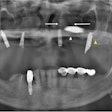
BOSTON - You're a master of the perfect porcelain veneer, the artful crown, the smooth-as-silk filling. Think again. Look at your work under a microscope and you'll find holes in your restoration you could drive a truck through. You'll also see things your naked eye -- and even X-rays -- will miss, from cracks to fissures to fractures.
That's the word from Roger Lacoste, D.M.D., clinical assistant professor of endodontics at Boston University School of Dental Medicine, who ran a hands-on workshop Thursday on "Microscopes in Modern Dentistry" at the Yankee Dental Congress 33 held in Boston this week. Lacoste should know -- he's an endodontist and microscopes are part and parcel of his surgical trade. But they can also reap huge benefits for general dentists.
To drive home his point, Lacoste put session attendees through a series of hands-on restorations -- first done the usual way (with the unaided eye or 2x loupes) and then using Global dental microscopes, which can magnify objects from 2.1 to 19.2x. The oohs, ahhhs, and dohs were audible, as the assembled discovered just how rough their first restorations were and how they radically improved using a microscope. "Look at this restoration," said one dentist, dropping a tooth in my hand. "Clinically, it looks fine. But under the microscope? You can see a star pattern of cracks."
"You'll see things with a microscope that won't necessarily show up in an X-ray," says Lacoste. Cracks, fissures, fractures, and more. And a microscope is a must if you're looking for elusive canals. "During one restoration, I not only discovered defects in my gutta-percha application, but I found a fifth canal -- something you wouldn't discover otherwise." Of course, a microscope does more than reveal flaws -- it lets you refine your work, be it polishing that amalgam, more carefully positioning membranes, or getting the margins right.
Some tips from Lacoste on getting started and getting the most out of a dental microscope:
- Your initial setup -- microscope and armature-cum-stand -- can run $30,000 for a top of the line model with video camera. But you can get a perfectly good setup for as little as $15,000.
- The more "steps" a microscope offers -- magnifications from 2 to 20x -- the better. "But you can get by with a three step scope that offers 4x, 10x, and 20x" says Lacoste. "For 2x, use a loupe."
- Choose the right mag for the job. For finding canals, Lacoste uses a high (15x or higher) setting; for surgery, medium magnification; for regular work with handpieces, low to medium magnification.
- Likewise, pick a microscope that lets you control the level of illumination. "Lighting is everything", says Lacoste. That includes angulation of your mirrors to properly illuminate the tooth. Getting that right, says Lacoste, is a pretty steep learning curve.
- The armature is key, says Lacoste, since it lets you adjust the microscope and properly focus without moving the patient around. "Look for a microscope with an inclinable binocular -- a flexible, fully adjustable eyepiece for your comfort."
- The many ways of mounting. Dental microscope vendors can mount the scope and armature from the ceiling, on the wall, or on a mobile, rollable stand.
- Think sturdy. "If you can't afford a microscope in every operatory, get a mobile unit and roll it from room to room. Just make sure it's built tough, like a Global unit."
And what about the patients? Will they be unnerved by yet another hunk of equipment hovering over them? "Not really," says Lacoste. "Patients don't seem to have a problem with the microscope. In fact, it boosts their confidence in you. 'Look at all this high tech equipment my dentist has!'"
Is a dental microscope up your alley? The best way to find out, says Lacoste, is to get a loaner for a couple of weeks. Most vendors will be happy to accommodate you.
Copyright © 2008 DrBicuspid.com

















